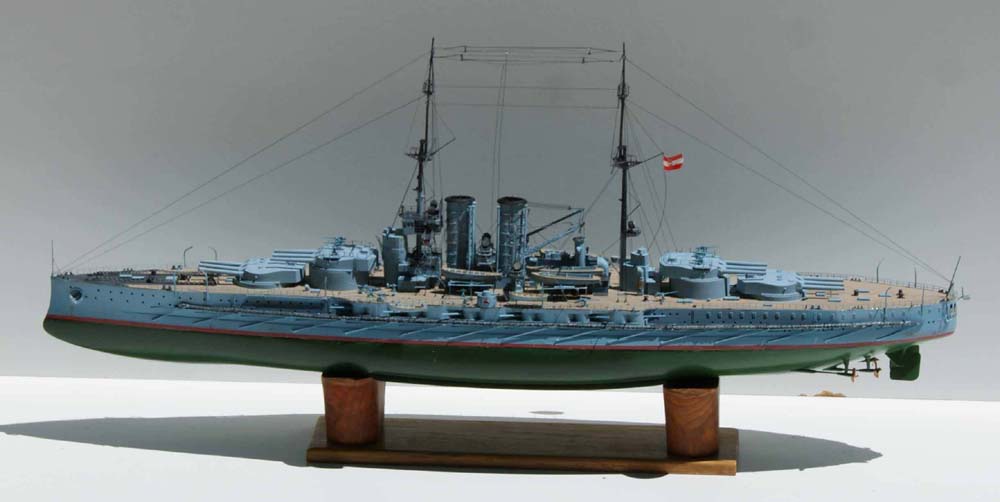
1/350 SMS Viribus Unitis (Combrig)
|
by Robert Apfelzweig |

1/350 SMS Viribus Unitis (Combrig)
Combrig released this kit about two years ago, apparently the first Austro-Hungarian warship in this scale. Aside from history buffs, most people are unaware that the Austro-Hungarian empire even had a navy, perhaps because it was little used and the only individual member of its officer corps to achieve any sort of fame (aside from Admiral Horthy, who led an independent Hungary after the Great War and through most of WWII) was Georg von Trapp, a successful submarine commander who later founded the well-known family singers of Sound of Music fame.I expressed a great deal of enthusiasm for this kit when I first purchased it from Freetime Hobbies, but it was not until last month that I actually got around to building it -- and my enthusiasm somewhat waned. On the plus side, the upper hull is beautifully cast and nearly all the smaller resin parts are crisp and precise, remarkably so when compared with other resin companies' products. Even the assembly instructions are exceptionally detailed, with some 15 images showing not only where the parts go, but how various assemblies should look once they have been completed. Unfortunately, the numerous resin parts, though illustrated on their sprues in the instructions, have no part numbers, and with many smaller ones it is sometimes difficult to determine exactly which ones are being referenced in the instructions. I was thus greatly helped by the many beautiful color computer-generated images of this ship in the Kagero 3D image publication by Andrew Wilkie and Friedrich Prasky, the purchase of which I would strongly recommend for anyone choosing to build this model. This book clearly shows the unusual "Hausian" blue upper hull and superstructure (rather like US Navy 5S, but lighter), which I sought to recreate from a mixture of Tamiya blue, light sea gray and flat white paints (mostly the latter), along with Tamiya wooden deck tan (lightened somewhat by adding flat white), dark green for the lower hull and "rosa" or pink for the boot topping, made by mixing flat red and flat white. The darker grey areas and upper masts are Tamiya German grey. The gun barrel muzzles, curiously, are copper-colored, for which I used Testor paint. Typical of Combrig kits, the flagstaffs, yardarms, torpedo net and other booms are provided only as written dimensions, but I obtained these, and all gun barrels (Combrig's are actually quite good) from MasterModel. Rigging was made from stretched black plastic sprue, and I used wound-wire picture-hanging cable for the anti-torpedo nets.
Other problems with this kit were that, at least in my set, the lower hull, though matching the upper one in waterline length, was several mm too narrow for the aft third, and this necessitated some careful putty and sanding work. Furthermore, there are no indentations or markings whatsoever on the lower hull to indicate precise placement of the rudders or propeller shafts or struts. Combrig provides two brass photoetch frets -- a smaller one for the anti-torpedo net platforms and some small boat supports and davits, and a larger one for everything else, which includes a generous amount of 2-bar railing. However, in my kit this larger fret was quite tarnished and many parts were broken or missing (in their places, empty slots). Combrig was apparently aware of this deficiency, as they had added a number of additional sections from a second large fret to compensate for what might be missing from the first, but I still had to scratch-build parts of both boat cranes with components from my spare parts boxes.
